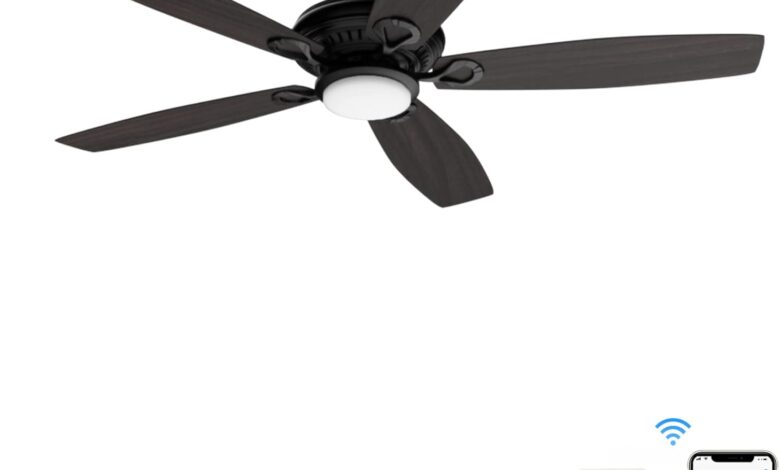
10 Facts for Installing Smart Ceiling Fan In 2024? In the rapidly evolving landscape of home automation, smart ceiling fans have emerged as a popular choice for homeowners seeking enhanced comfort, convenience, and energy efficiency. Unlike traditional ceiling fans, which operate manually or through basic remote controls, smart ceiling fans integrate seamlessly with smart home systems, offering a range of advanced features and benefits.
Table of Contents
ToggleEnergy Efficiency Benefits
One of the primary advantages of smart ceiling fans is their energy efficiency. These fans are equipped with sensors and algorithms that optimize airflow based on room occupancy, temperature, and humidity levels. By automatically adjusting speed and direction, smart ceiling fans reduce energy consumption and contribute to lower utility bills.
Integration with Smart Home Systems
Smart ceiling fans can be integrated with popular smart home platforms such as Amazon Alexa, Google Assistant, and Apple HomeKit. This integration allows users to control fan settings using voice commands or mobile apps, providing a seamless and intuitive user experience.
Enhanced Comfort and Convenience Features
Beyond basic airflow control, smart ceiling fans offer a range of comfort and convenience features. These may include customizable fan speed profiles, programmable schedules, sleep mode settings, and even compatibility with wearable devices for personalized comfort optimization.
Cost Considerations and Savings
While the initial investment in a smart ceiling fan may be higher than that of a traditional fan, the long-term cost savings are substantial. The energy-efficient operation, coupled with the ability to fine-tune settings for optimal comfort, can lead to significant savings on electricity bills over time.
Installation Process Overview
Installing a smart ceiling fan typically involves replacing an existing fan or light fixture. Most smart fans come with detailed installation instructions and may require basic electrical wiring knowledge. Professional installation services are also available for those who prefer assistance.
Compatibility with Existing Infrastructure
Smart ceiling fans are designed to work seamlessly with existing home infrastructure, including Wi-Fi networks and smart hubs. Compatibility checks and software updates ensure smooth integration and ongoing performance optimization.
Maintenance and Troubleshooting Tips
Like any electrical appliance, smart ceiling fans require regular maintenance to ensure optimal performance. Simple tasks such as cleaning fan blades, checking connections, and updating firmware can extend the lifespan of the fan and prevent common issues.
Safety and Security Features
Smart ceiling fans often incorporate safety features such as automatic shut-off in case of overheating or unusual operation. Some models may also include built-in sensors for detecting smoke or carbon monoxide, enhancing home safety.
Environmental Impact and Sustainability
In addition to energy savings, smart ceiling fans contribute to environmental sustainability by reducing carbon emissions associated with electricity usage. Choosing ENERGY STAR certified models further emphasizes eco-friendly practices.
Comparison with Traditional Ceiling Fans
When comparing smart ceiling fans to traditional fans, the advantages are clear. Smart fans offer greater control, energy efficiency, and convenience, making them a worthwhile investment for modern homes.
Consumer Reviews and Recommendations
Feedback from users of smart ceiling fans is overwhelmingly positive, with many praising the ease of use, energy savings, and enhanced comfort. Online reviews and recommendations can help prospective buyers make informed decisions.
Read More: 7 Things You Should Know Before Purchasing Your First Drone
Future Trends and Innovations
The future of smart ceiling fans looks promising, with ongoing innovations such as advanced AI algorithms, improved connectivity options, and integration with smart building management systems. These developments will further enhance functionality and user experience.
Conclusion
Smart ceiling fans represent a significant advancement in home comfort and energy efficiency. With their array of features, seamless integration with smart home systems, and potential for long-term cost savings, these fans are an attractive choice for modern households.
FAQs : Installing Smart Ceiling Fan
Are smart ceiling fans difficult to install?
Installing a smart ceiling fan requires basic electrical knowledge and can be done DIY or with professional help.
Can smart ceiling fans save on energy costs?
Yes, smart ceiling fans are designed for energy efficiency and can lead to savings on electricity bills.
Do smart ceiling fans work with voice assistants?
Most smart ceiling fans are compatible with popular voice assistants like Alexa and Google Assistant.
What maintenance is required for smart ceiling fans?
Regular cleaning, checking connections, and firmware updates are recommended for optimal performance.
Are smart ceiling fans environmentally friendly?
Yes, smart ceiling fans contribute to environmental sustainability by reducing energy consumption.











